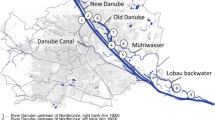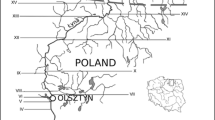Abstract
We examined the significance and suitability of Aeromonas hydrophila versus fecal coliforms in assessing microbiological water quality. For this, we used the membrane filtration method to simultaneously estimate the abundance level of A. hydrophila and fecal coliforms in waters from the Mfoundi river watershed at Yaoundé, and compared how fluctuations in A. hydrophila abundance matched those observed with fecal coliforms index as an indicator of water quality in the system under study. Our results revealed that waters were not safe according to the standards for water quality established by the Word Health Organization (WHO). They also indicated the prevalence of A. hydrophila as compared to fecal coliforms, and suggested that water from the Mfoundi River and its tributaries could be classified as hypereutrophic based on the density of Aeromonas. Moreover, the spatial distribution of fecal coliforms and A. hydrophila exhibited similar trends within the different water bodies investigated, suggesting that A. hydrophila can be used as indicator of water quality in highly polluted waters. We concluded that waters from the Mfoundi River watershed at Yaoundé represent a great potential risk of infection for users, and foresee that the next challenge will be to determine, among other factors, the physico-chemical factors influencing the observed spatial distribution.



Similar content being viewed by others
References
APHA (1992) Standard methods for the examination of water and wastewater. Washington, DC
Araujo RM, Arribas RM, Lucena F, Pares R (1989) Distribution of mesophilic aeromonads in temperate aquatic habitats-relationship with fecal indicators. Water Sci Technol 21:247
Austin B, Altwegg M, Gosling PJ, Joseph SW (1996) The genus Aeromonas. Wiley and Sons Ltd, New York
Burke V, Robinson J, Gracey M, Peterson D, Meyer N, Haley V (1984a) Isolation of Aeromonas spp. from an un-chlorinated domestic water supply. Appl Environ Microbiol 48:367–370
Burke V, Robinson J, Gracey M, Peterson D, Partridge K (1984b) Isolation of Aeromonas hydrophila from a metropolitan water supply: seasonal correlation with clinical isolates. Appl Environ Microbiol 48:361–366
Canosa A, Pinilla G (1999) Bacteriological eutrophication indicators in four Colombian water bodies (South America). Lakes Reservoirs: Res Manage 4:23–27. doi:10.1046/j.1440-1770.1999.00079.x
Chao K-K, Chao C-C, Chao W-L (2003) Suitability of the traditional microbial indicators and their enumerating methods in the assessment of fecal pollution of subtropical freshwater environments. J Microbiol Immunol Infect 36:288–293
Daily OP, Joseph SW, Coolbaugh JC, Walker RI, Merrell BR, Rollins DM et al (1981) Association of Aeromonas sobria with human infection. J Clin Microbiol 13:769–777
Djuikom E, Njine T, Nola M, Sikati V, Jugnia L-B (2006) Microbiological water quality of the Mfoundi River watershed at Yaoundé, Cameroon, as inferred from indicator bacteria of fecal contamination. Environ Monit Assess 122:171–183. doi:10.1007/s10661-005-9172-7
Goñi-Urriza M, Capdepuy M, Raymond N, Quentin C, Caumette P (1999) Impact of an urban effluent on the bacterial community structure in the Arga River (Spain), with special reference to culturable Gram-negative rods. Can J Microbiol 45:826–832. doi:10.1139/cjm-45-10-826
Griesel M, Jagals P (2002) Faecal indicator organisms in the Renoster Spruit system of the Modder-Riet River catchment and implications for human users of the water. Water SA 28:227–234
Guillaud JF, Derrien A, Gourmelon M, Pommepuy M (1997) T90 as a tool for engineers: Interest and limits. Water Sci Technol 35:277–281. doi:10.1016/S0273-1223(97)00272-2
Havelaar AH, During M, Wersteegh JFM (1987) Ampicillin dextrin agar medium for the enumeration of Aeromonas species in water by membrane filtration. J Appl Bacteriol 62:279–287
Hirotani H, Sese C, Kagawa H (1999) Correlations of Aeromonas hydrophila with indicator bacteria of water quality and environmental factors in a mountain stream. Water Environ Res 71:132–138. doi:10.2175/106143099X121544
Howell JM, Coyne MS, Cornelius PL (1996) Effect of sediment particle size and temperature on fecal bacteria mortality rates and the fecal coliform/fecal streptococci ratio. J Environ Qual 25:1216–1220
Janda JM, Abbott SL (1998) Evolving concepts regarding the genus Aeromonas: an expanding panorama of species, disease presentations and unanswered questions. Clin Infect Dis 27:332–344. doi:10.1086/514652
Jugnia L-B, Nsimé-Ngando T (2001) An assessment of the impact of Mingoa stream input to the bacteriological quality of the Municipal Lake of Yaoundé (Cameroon). Water Resour Manage 15:203–209. doi:10.1023/A:1013059108329
Kersters I, Van Vooren L, Huys G, Janssen P, Kersters K, Verstraete W (1995) Influence of temperature and process technology on the occurrence of Aeromonas species and hygienic indicator organisms in drinking water production plants. Microb Ecol 30:203–218. doi:10.1007/BF00172575
Legnami P, Leoni E, Soppelsa F, Burigo R (1998) The occurrence of Aeromonas species in drinking water supplies of an area of the dolomite Mountains, Italy. J Appl Microbiol 85:271–276. doi:10.1046/j.1365-2672.1998.00499.x
Medema GM, Bahar M, Schets FM (1997) Survival of Cryptosporidium parvum, Escherichia coli, fecal enterococci and Clostridium perfringens in river water: influence of temperature and autochthonous microorganisms. Water Sci Technol 35:249–252. doi:10.1016/S0273-1223(97)00267-9
Miranda CD, Castillo G (1996) Isolation and characterization of motile Aeromonas from Chilean freshwaters and their potential use as water quality indicators. Environ Toxicol Water Qual 11:91–98. doi :10.1002/(SICI)1098-2256(1996)11:2≤91::AID-TOX3≥3.0.CO;2-3
Monfort P, Baleux B (1990) Dynamics of Aeromonas hydrophila, Aeromonas sobria and Aeromonas caviae in a sewage treatment pond. Appl Environ Microbiol 56:1999–2006
Monfort P, Baleux B (1991) Distribution and survival of motile Aeromonas spp. in brackish water receiving sewage treatment effluent. Appl Environ Microbiol 57:2459–2467
Okpokwasili GC, Akujobi TC (1996) Bacteriological indicators of tropical water quality. Environ Toxicol Water Qual 11:77–81. doi :10.1002/(SICI)1098-2256(1996)11:2≤77::AID-TOX1≥3.0.CO;2-5
Payne I (1986) The ecology of tropical lakes and rivers. Wiley, New York
Rippey SR, Cabelli VJ (1979) Membrane filter for enumeration of Aeromonas hydrophila in fresh waters. Appl Environ Microbiol 38:108–113
Rippey SR, Cabelli VJ (1985) Growth characteristics of Aeromonas hydrophila in limnetic water of varying trophic state. Arch Hydrobiol 104:311–319
Rippey SR, Cabelli VJ (1989) Use of thermotolerant Aeromonas group for the trophic state classification of freshwater. Water Res 23:1107–1114. doi:10.1016/0043-1354(89)90154-1
Rippey SR, Troy MA, Cabelli VJ (1994) Growth kinetics of Aeromonas hydrophila in freshwater supplemented with various organic and inorganic nutrients. World J Microbiol Biotechnol 10:159–164. doi:10.1007/BF00360878
Sall J, Lehman A, Creighton L (2001) JMP start statistics A guide to statistics and data analysis using JMP and JMP IN software. SAS Institute Inc., Carey
Seidler RJ, Allen DA, Lockman H, Colwell RR, Joseph SW, Daily OP (1980) Isolation, enumeration, and characterization of Aeromonas from polluted waters encountered in diving operations. Appl Environ Microbiol 39:1010–1018
Springthorpe VS, Loh CL, Sattar SA (1997) How good is modeling of microbial survival in fluvial systems? Water Sci Technol 35:253–259. doi:10.1016/S0273-1223(97)00269-2
Suchel B (1987) Les climats du Cameroun. Th. Doct. Univ, Bordeaux III
WHO (1998) Guidelines for safe recreational-water environments. WHO/EOS/98, Geneva
Acknowledgements
The authors gratefully acknowledge logistical support provided by Drs L. Polla and S. Foto, and would also like to thank Dr. D. Juck for critical reading of the manuscript.
Author information
Authors and Affiliations
Corresponding author
Rights and permissions
About this article
Cite this article
Djuikom, E., Njiné, T., Nola, M. et al. Significance and suitability of Aeromonas hydrophila vs. fecal coliforms in assessing microbiological water quality. World J Microbiol Biotechnol 24, 2665–2670 (2008). https://doi.org/10.1007/s11274-008-9793-4
Received:
Accepted:
Published:
Issue Date:
DOI: https://doi.org/10.1007/s11274-008-9793-4




